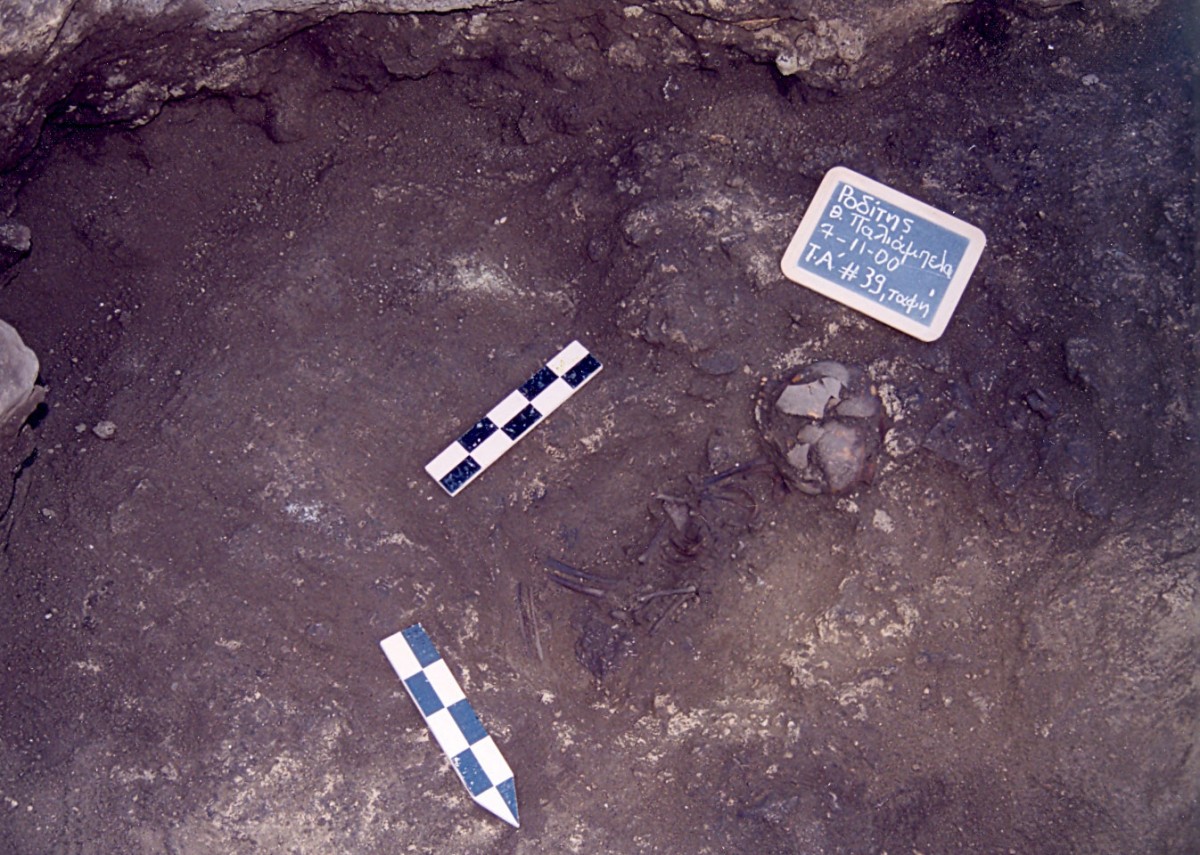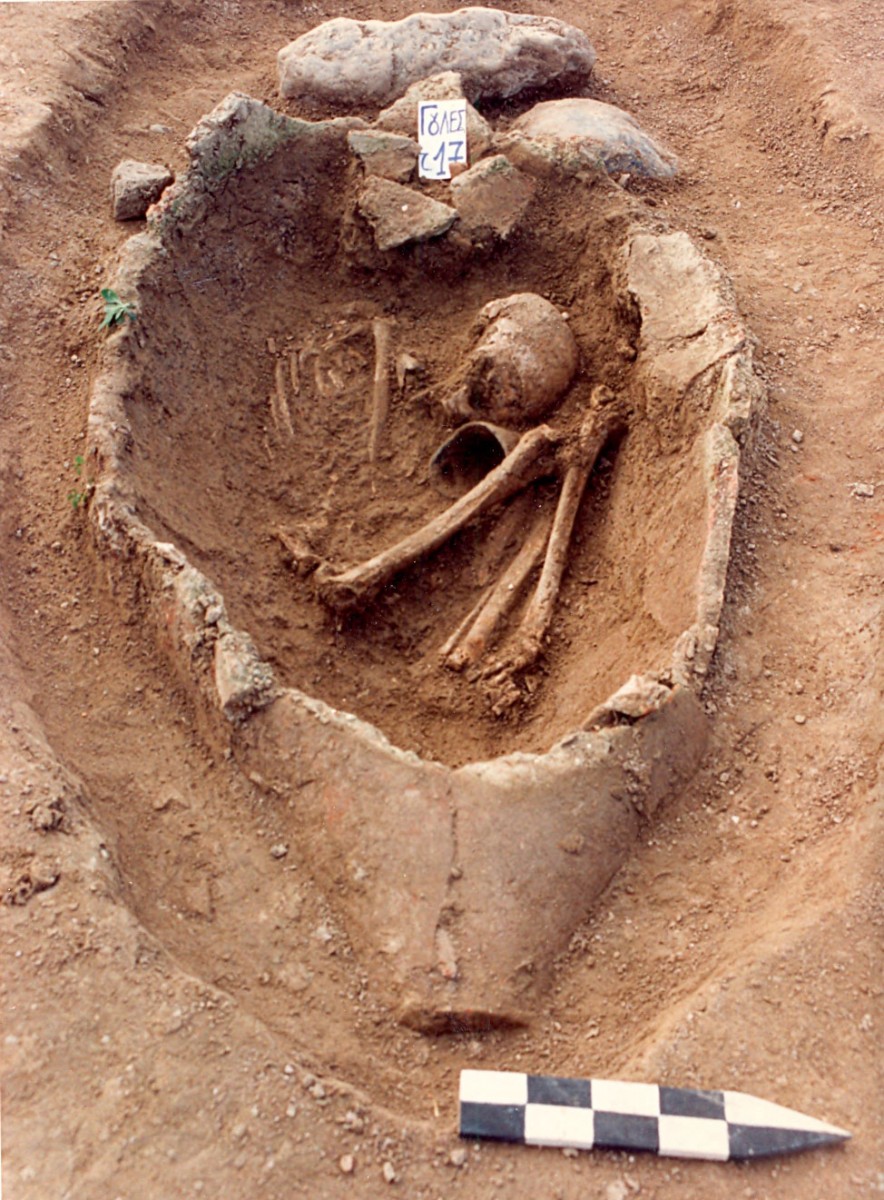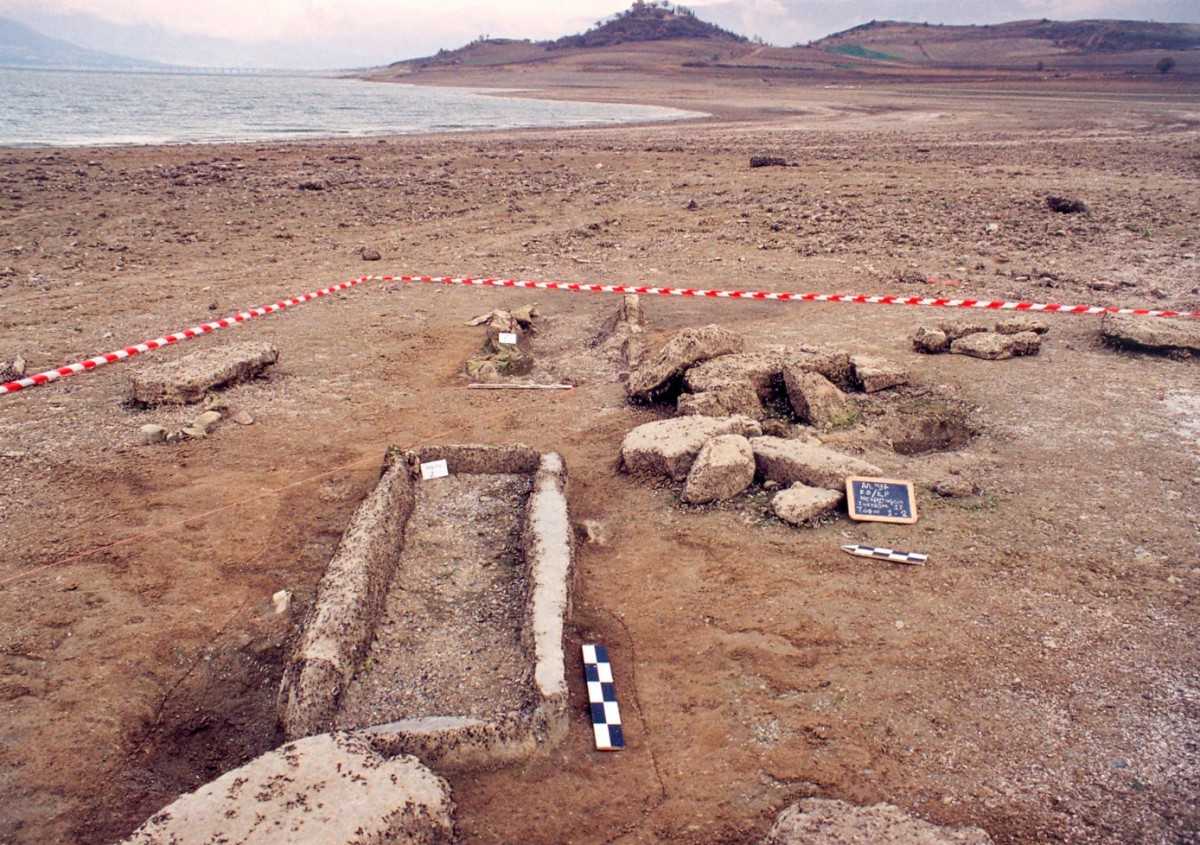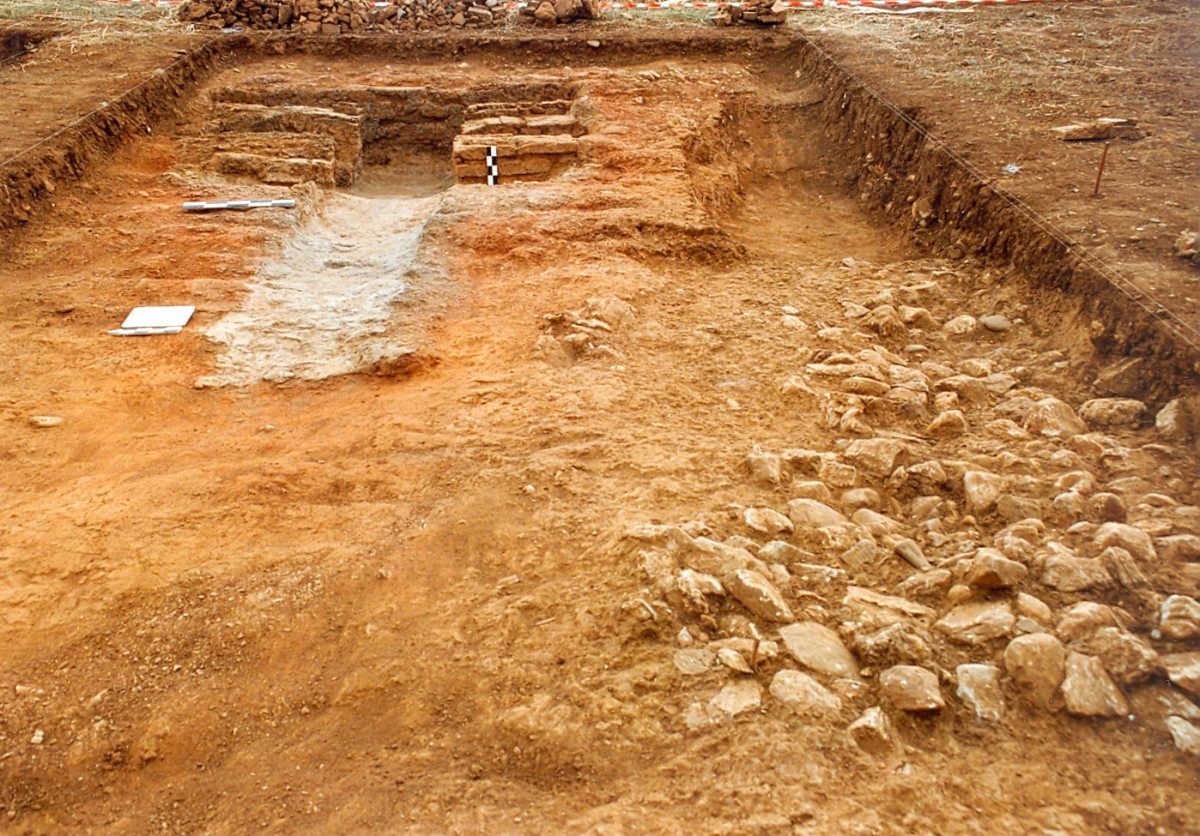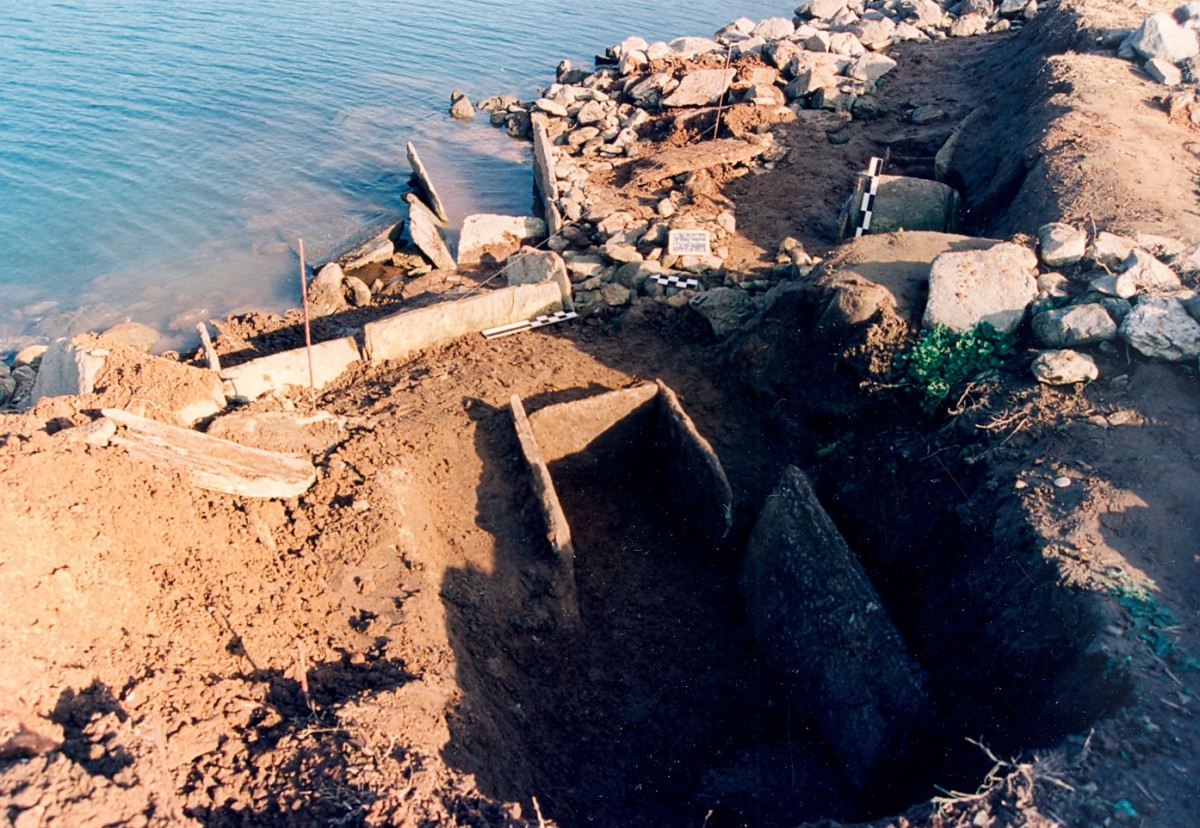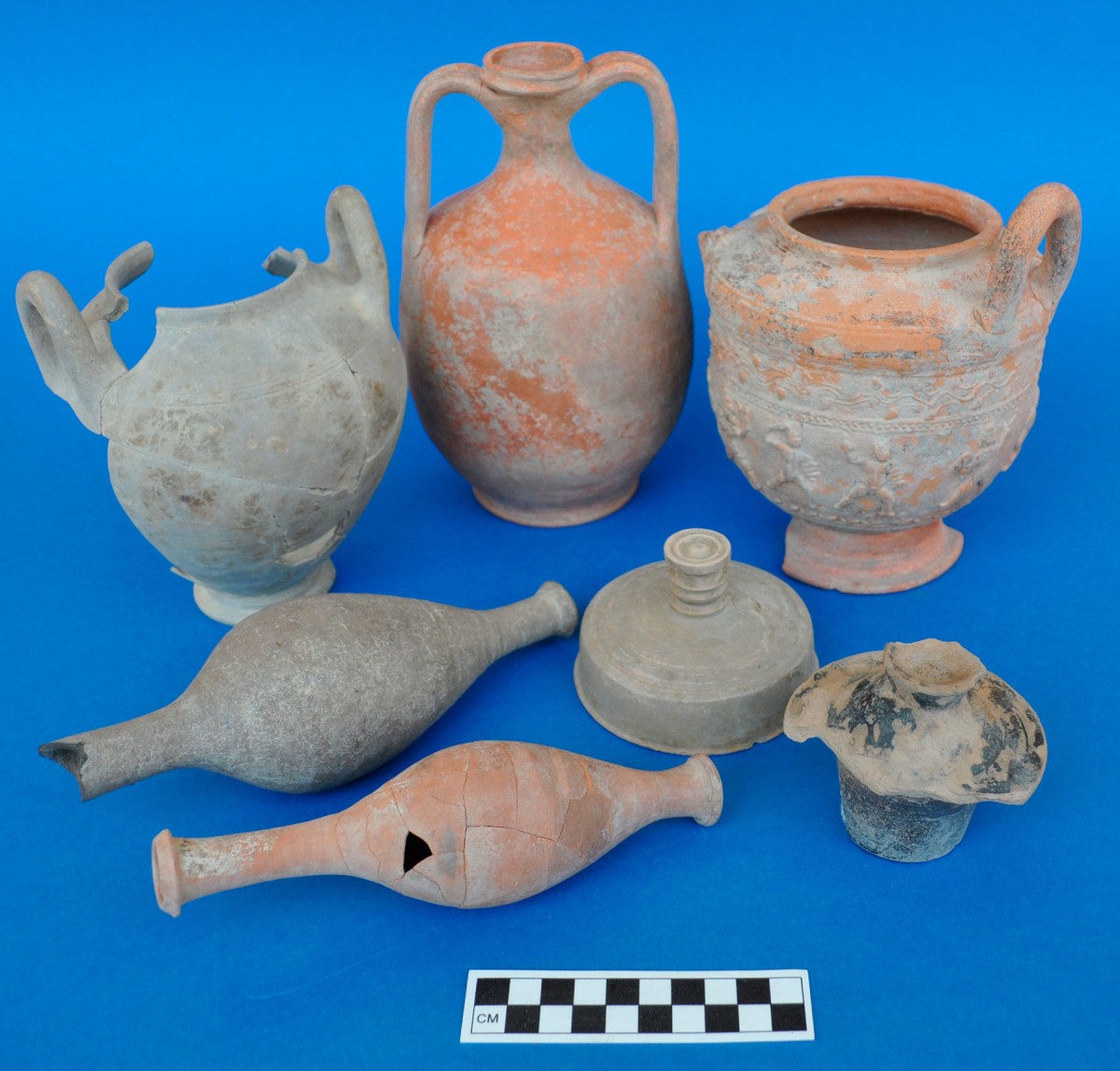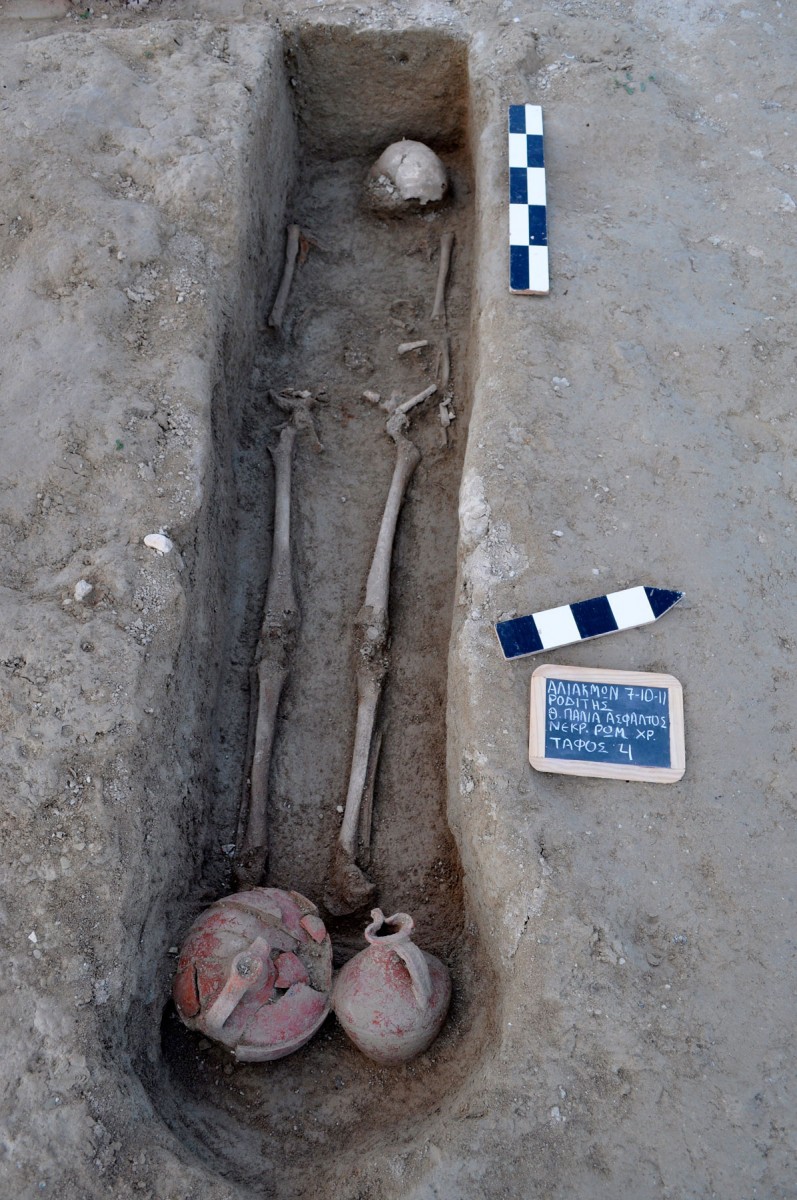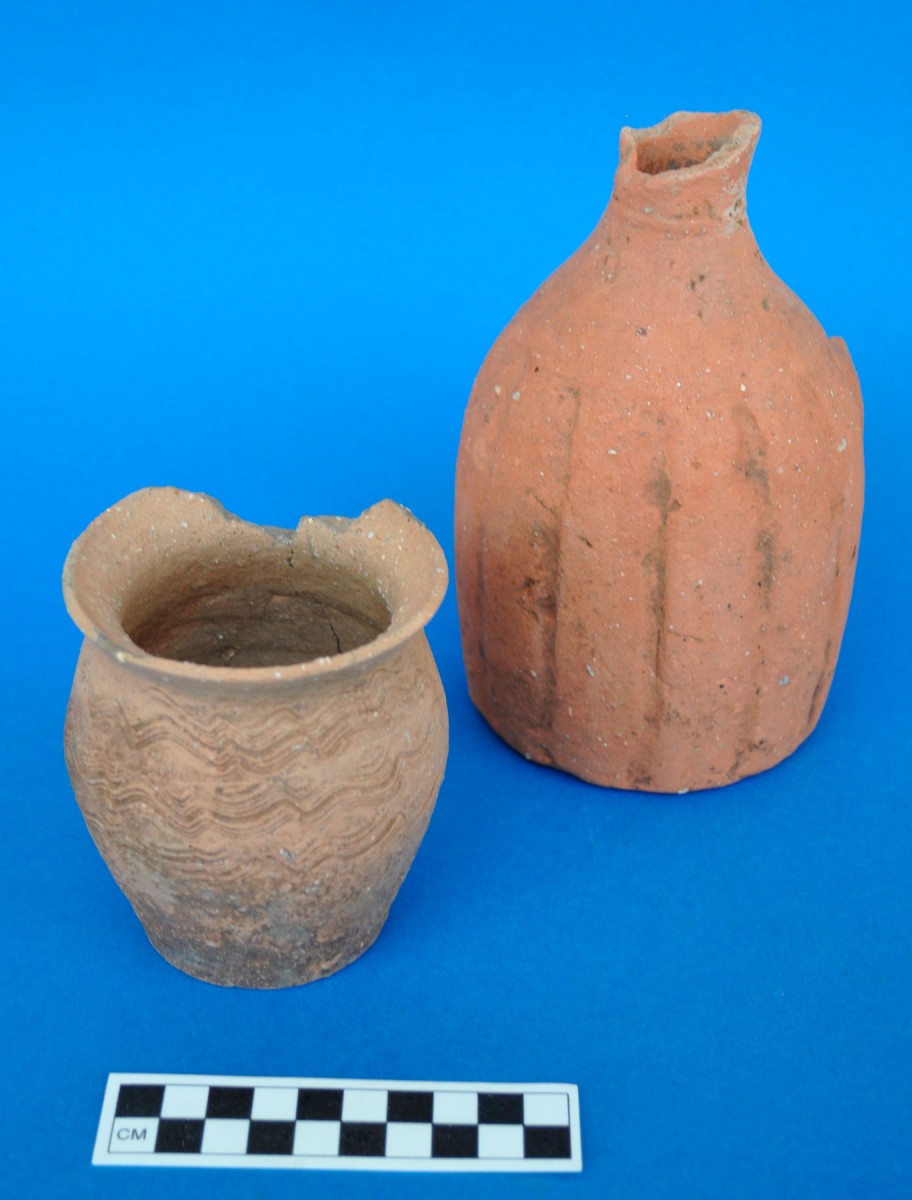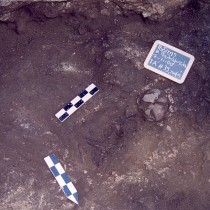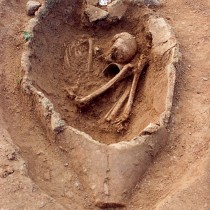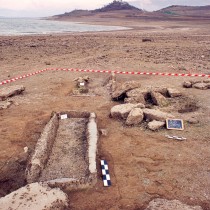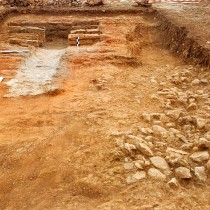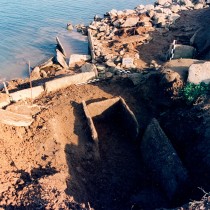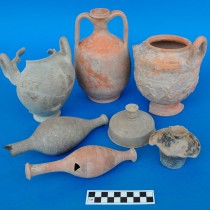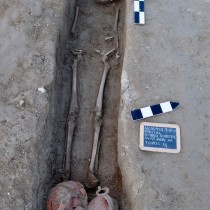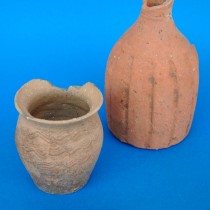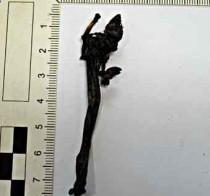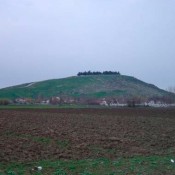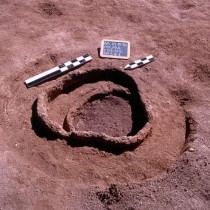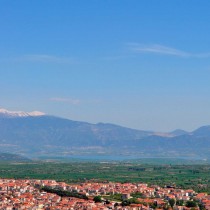Archaeological research in the Middle Haliakmon valley, from 1985 onwards, resulted in the detection of 41 (note 1) cemeteries or isolated burials, spanning almost all periods of history and prehistory. Most of them are located along the shore of the Polyfytos artificial lake and thus are greatly affected by the lake water, while others have been recovered through excavation. The data is presented chronologically, in an attempt to approach the subject of the treatment of the dead in the region diachronically (note 2).
Neolithic period (6700/6500-3300/3100 BC, note 3)
There are only two known Neolithic burials in the region (note 4). They are located within settlements and date to the Early and Late Neolithic period (note 5). A pit burial of a child, in the settlement of Paliampela Roditis belongs to the Early Neolithic (fig. 1), while a Late Neolithic cremation burial was located in the settlement Varemeni Goules, with the bones of the deceased placed in an urn.
The aforementioned examples are isolated burials within settlements (note 6). Organized cemeteries located outside settlements have not yet been detected in the area (note 7). The burial practices of inhumation in contracted position and cremation are used, with possible differentiated treatment of the children. The inclusion of grave offerings with the burials is certain.
Bronze Age period (3300/3100-1100 BC)
The examples of burials that have come to light until now are dated almost exclusively to the advanced phases of the period, in the 2nd millennium.
A disturbed pit burial probably dates to the beginning of the Early Bronze Age. It was found next to a building of the same period, in the settlement at Faraggi Mesiani (note 8).
Two cemeteries and four isolated burials belong to the Middle Bronze Age.
The first cemetery is at Tourla Goules, at a distance of 300 m. from the contemporary settlement. Although it was already eroded by the lake by the time it was detected, the excavation brought to light important evidence about the burial practices and ideology of this period (note 9). Forty-three burials were investigated: two cremations, 14 inhumations in cist graves, 26 burials inside large pithoi (fig. 2) or smaller pithoid vessels and one pit grave covered with sherds from pithoid vessels. Seven in a total of 41 burials belonged to children. The graves are all oriented southwest-northeast, with the heads of the deceased (and the rims of the burial pithoi) pointing southwest.
The second cemetery is at Polemistra Aiani. Here, under a four-meter terrace in the scarp created by the lake, inside the terrace of a pre-existent settlement and very close to the settlement of this period, were located four eroded burials. They include three urn-burials (one in a pithos and two child burials in smaller vessels) and one pit grave with covering slabs. The pithos and the pit burial shared the same east-west orientation, with the rim of the vessel in the east, where the head of the deceased must also have been located.
The isolated burials are located inside the settlements, outside or next to entrances of houses. They include two urn-burials, one with a child burial, in the settlement of Polemistra Aiani, and one destroyed urn-burial and (possibly) a pit burial, with the deceased in a contracted position, in the settlement at Paliochano Sparto.
From these burial remains the following can be concluded regarding the Middle Bronze Age: it was customary, perhaps only for children, that they be buried inside the settlement at the same time as the use of extended, organized extramural cemeteries. Three burial types are in use: cist graves, pit graves with covering slabs or parts of vessels and urn-burials inside pithoi or smaller vessels. In the case of urn-burials, the vessels are placed on their sides. The graves have the same orientation. Inhumation and cremation are in parallel use, although the second to a far more limited degree. The bodies are buried in a severely contracted position, to their right or their left, possibly according to their sex, and, in the case of urn-burials, with their head towards the rim of the vessel. In the organized cemeteries the deceased are usually accompanied by funerary items, a vessel and a little jewellery or other artifacts.
Only one cemetery is dated with certainty to the Late Bronze Age. It is located at Kryovrysi Kranidia (note 10), inside the terrace of the Neolithic settlement. Eight cist graves were explored, almost all eroded and disturbed by the lake. The long sides of four of them were constructed with stone anthropomorphic stelae, probably Neolithic, in secondary usage. Their narrow sides, as well as the rest of the graves, were built with small clay slabs (fig. 3). All the graves have the same southwest-northeast orientation, with the heads of the deceased in either direction. The deceased were adults, buried sideways, with their legs slightly bent. They were accompanied by more or less luxurious grave-offerings, while the only grave found undisturbed contained no grave goods at all. A clay vessel constituted a common offering, while in one of the graves, perhaps the richest of all, a Mycenaean high-stemmed kylix, two pieces of gold jewellery, a bronze ring, four terracotta whorls and an amber bead were all found together. Two Mycenaean vessels date the use of the cemetery from the mid-13th century BC to the mid-11th century BC.
Another three, cemeteries, all small and eroded by the lake, are probably also to be dated in the Late Bronze Age, based on the finds so far and the characteristics that can be attributed to this period (note 11). They are located in the sites Kato Bravas Velvendo (three disturbed pit graves with covering slabs and of similar orientation), Skamnies Servia (a destroyed cist grave) and Palaiokastro Kaisareia (a pit grave).
Based on the above data, the following can be concluded about the burial of the dead, at least at the end of the Late Bronze Age: the dead are buried in small cemeteries, very close or next to the settlement. The form of cist or pit grave with covering slabs is in use. The graves share the same orientation. The existence of clusters is notable, possibly reflecting an analogous social organization. The burial practice selected is inhumation, with the deceased placed on their side, with their legs slightly bent. They are accompanied by several, sometimes luxurious grave-offerings. The total data suggest the strong influence exerted by the Mycenaean culture in the region.
Early Iron Age (1100-700 BC)
In the transitional period between the Late Bronze Age and the Early Iron Age can be dated an excavated cemetery (note 12), located at Kampos Frourio, in the area of the Middle Aliakmon-Ilarion Dam (note 13). It is a small organized, cemetery, in very close vicinity to the settlement. A total of six graves were uncovered. Two of them are of large dimensions, cut into the bedrock, with a circular chamber and long entrance passage (dromos), and probably once vaulted. They have the same east-west orientation, with the dromos located in the west. The remaining four are small, rock cut, circular graves which preserve traces of two steps in one of their sides. Their position was probably indicated by stone cairns. The cemetery sustained significant damage during its second usage during Roman times, when the vessels accompanying the deceased as grave-goods were smashed and used for the back-filling of a natural cavity (fig. 4). Among them 17 fragments of bronze jewellery (beads, part of a pair of tweezers, a spearhead, a “syrinx”, and a ring) were found. The deceased were inhumed, while the two large structures that seem to have been used for more than one burial, were probably family graves. The pottery in its entirety was handmade, with variations of forms reminiscent of the Mycenaean repertoire, although elements derived from the local tradition were also present. The data set indicates the strong influence of the Mycenaean tradition and dates the cemetery to the 11th century.
In late phases of the Early Iron Age (note 14) three cemeteries can be assigned, all of them almost completely eroded by the water of the Polyfytos lake.
The first one is located at Bair or Kolitsaki Servia (note 15). Four cist graves were excavated, similarly oriented east-west, containing inhumations. The deceased were in a supine position, with their hands placed across the chest and the head to the east, while in one case there was a re-interment of bones. They were accompanied by 4 or 5 clay vessels and a few pieces of jewellery. The vessels include some with matt-painted decoration and one Proto-geometric wheel-made skyphos that dates the cemetery.
The second is situated at Kryovrysi Kranidia (note 16), in a plateau adjacent to that where the Late Bronze Age cemetery is located. Three cremation urns were collected there. Among them is one wheel-made amphora with painted Protogeometric style decoration of, that contained cremated remains. Three more, two wheel-made amphorae with painted Protogeometric style decoration of and one handmade hydria, all completely shattered, probably also contained cremations. The urn-burial of a young child in a handmade amphora was also discovered. The deceased was placed in a contracted position, on the right side and head to the northwest. The findings suggest that it is a Protogeometric cemetery with cremation as the most common burial practice.
The third cemetery is located at Kato Bravas Velvendo (fig. 5). Four cist graves with no uniform orientation were excavated. From the single non-eroded burial it can be inferred that the deceased were placed in a supine position. Two re-interments of bones were recovered in this grave. The latest burial belonged to a woman, accompanied by grave-offerings, 3 vessels and several items of bronze jewellery, such as a figure of eight-shaped fibula, earrings and various other spiral jewels. Beads from clay and glass were also found. The vessels were handmade except for a wheel-made jug with cut-away neck, which places the earliest use of the cemetery in Geometric times. Stone cairns were identified in the area, which probably served as grave markers.
According to this data, the following can be inferred about the Early Iron Age: there is a variety in the grave types of this period as well as in the burial practices, with the mingling of two cultural traditions, the Proto-geometric from Southern Greece in sites nearest to the natural route to Thessaly, and the local (or northern) in the more remote areas, where the Mycenaean tradition survives for a long period of time. In the later phases of the same era, the local (or northern) tradition prevails.
During this period the burial of the dead occurs in extended, organized cemeteries, as well as in smaller ones, in very close proximity to the settlement. In the early phases these follow the Late Bronze Age tradition. The cist grave is apparently the dominant type in sites not influenced by the Mycenaean tradition. Those employ circular rock cut graves. Urn-burials are also present. The orientation of the graves is inconsistent, at least in the later cemeteries of the Geometric times. Inhumation is more often practiced, mainly in the cemeteries of the Geometric times, where re-interment of the bones can also be observed as well as in earlier ones following the Mycenaean tradition. Cremation seems to be the rule for the burial of adults in the Proto-geometric cemeteries, that follow the new fashions originating from South Greece, and in which inhumation is used occasionally, inside urns, although perhaps only for young children. The bodies inside the cist graves are placed in a supine position while in the urn-burials they are contracted. Grave offerings are numerous in the inhumation cemeteries, but seem to be absent in the cremation cemeteries. The marking of graves or burials with stone cairns is likely.
Archaic, Classic, Hellenistic era (700-30 BC)
The information available from the lakeside region for the first two periods is scanty, limited to some vessels which were offerings in graves eroded by the lake, found at Kato Bravas Velvendo (note 17).
In contrast, finds of the Hellenistic period are much more numerous. Four cemeteries were located (note 18), eroded to various degrees by the water.
Two of them lie on adjacent plateaus in Gefyra Neraida site, usually covered by the lake water. The graves located (4 and 7 respectively) are cist graves, with varied orientation, and contained inhumations. Four terracotta female figurines that were handed in by locals should be associated with one of these.
The third cemetery of the period is located at Agia Varvara Servia. Here, a pit burial of a young child in a supine position was excavated. Nine clay vessels that were handed in to us belonged to this burial, while 7 more to a second eroded one (fig. 6). To the right of the dead individual, next to the head, was found a clay vessel (stamnos), while at the level of the abdomen height there was a clay lid from a vessel.
The fourth cemetery lies at Paliochori Neraida. The graves are cists, without fixed orientation. The osteological material dispersed in the area revealed that they contained inhumations. The dead were accompanied by grave offerings. Eight clay vessels were collected along with some iron artifacts, all offerings from eroded graves.
Another four (note 19) cemeteries belong to the Hellenistic era, as inferred by vessels or other artifacts that were handed-in or recovered recently, during survey. One is located at the lakeside site of Kato Bravas Velvendo and three more in the wider region: at Akmaxiz Lefkara, Palaiogratsano and Panagia Servia. In the latter the graves were probably tile-covered.
According to the above evidence, the following observations can be made for the Hellenistic period as a whole: the deceased are buried in extended organized cemeteries, well away from the settlement. The grave type so far attested is the cist, whilst there is, however, evidence for tile-covered graves as well. The burial practice employed was inhumation. The graves do not have a uniform orientation. The deceased are accompanied by grave goods such as numerous vessels, figurines and other personal objects.
Roman era (30 BC-300 AD)
Six cemeteries (note 20) are dated to the Roman period.
Two of them, one of uncertain date, are located at Kolitsaki or Bair Servia (note 21). In the first, 25 graves were excavated, almost all pit graves with or without covering slabs and one tile-covered. The bodies are placed in the supine position, with their arms beside the body. The grave orientation is uniform, northeast-southwest, with the heads of the deceased pointing southwest. Most of them have no grave offerings, some contained bronze coins and two had one clay vessel each. In the second cemetery a small cluster of pit graves with cover slabs was explored.
The third cemetery is situated at Varemeni Goules. It consists of four destroyed graves, possibly pit graves that contained inhumations. Associated with the cemetery, as grave goods, are one bronze coin and two pieces of clay vessels.
The fourth cemetery is located at Keramopiio Goules. It is eroded by the lake and destroyed by looters. The graves were built out of stones and tiles, while the scattered osteological material suggests that they contained inhumations. Some bronze jewellery and a silver coin of Alexander Severus, all grave offerings, have been handed in from the area.
At Agia Varvara Servia, a cist grave with northwest-southeast orientation was excavated. The deceased was placed in the supine position, with the arms beside the body and the head pointing southeast. Above the pelvis was found an aryballoid vessel whereas an oenochoe was located on the left thigh.
Another cemetery of this period eroded by the lake is located at Palia Asphaltos Roditis. Eight eroded pit graves containing inhumations were located. They had similar orientation, northwest-southeast, with the heads of the deceased pointing towards the northwest in all three preserved cases. One of them contained two vessels placed between the legs of the deceased as grave offerings (fig. 7). Many clay and some glass vessels from this area that represent grave offerings have been handed in to us.
From these examples the following can be said about Roman burial practices: the deceased are buried in extended or smaller organized cemeteries, well away from the settlements. The grave types occurring are cists, shafts with cover slabs, and tile-covered graves (note 22). The deceased are buried in single graves, in the supine position. The orientation of the graves is fixed. The grave goods are scant, usually only a clay vessel and the jewellery of the deceased, while the habit of coin deposition is fairly common.
Christian times (300 AD onwards)
Five cemeteries (note 23) from the Early Christian until the Late Byzantine times are all eroded by the lake water.
They are located in the sites of Kolitsaki or Bair Servia (32 graves excavated, most of them shaft graves with covering slabs and a few cist graves), Xerolakkas Avles (3 graves excavated, shaft graves with covering slabs), Agios Konstantinos Kaisareia (5 graves excavated, shaft graves with covering slabs or cist graves), Agios Nikolaos Velvendo (4 cist graves excavated) (fig. 8), Paliokastania Servia (17 cist graves located, one of them excavated).
Four more cemeteries located far from the lake belong to the Ottoman period. Two of them, in the sites Mnimata Vathylakkos and Agios Georgios Lefkara, are Turkish, while the other two, in the sites Akmaxiz Lefkara and Paliomonastiro Platanorrevma, are Christian.
Based on the above data it is evident that, during Christian times, the deceased were buried in cist graves or shaft graves with covering slabs. The graves are all oriented west-east, with the heads of the deceased in the west. The bodies are placed in the supine position, with the arms beside the body or crossed over the chest or abdomen, while re-interments of bones are also encountered. No grave offerings are placed inside the graves except for the personal jewellery of the deceased. The few vessels found either represent grave goods of earlier burials (Early Christian times) or are associated with funerary rites.
Observations – Conclusions
The burial remains constitute an important field of research, especially in relation to prehistory, since the treatment of the dead, varying from period to period and from one community to another, not only projects a series of ritual acts but also manifests the ideological conceptions dictating them.
The diachronic approach to the burial data to-date from the area of the Polyfytos artificial lake and the formerly riverine region, suggests a limited diversification of the treatment of the dead and of the ideology concerning death in all periods from current knowledge concerning the rest of the Greek territory.
The earliest burial remains date back to the Early Neolithic period. Until nearly the end of the 3rd millennium BC there are only a few located burials. They are mostly isolated inhumations within the settlements. The absence of cemeteries dated to these periods but also of burials corresponding in number to the estimated population, suggests differential burial treatment of the majority, in ways that are probably undetected by the archaeological research.
Extended organized extramural cemeteries, well away from the settlements appear, according to the data currently available, in the early Middle Bronze Age, around 2000 BC. Nevertheless burial within the settlement constitutes a burial practice that continues also in the first half of the 1st millennium BC, perhaps exclusively for children. During the Late Bronze Age and Early Iron Age small burial clusters appear, as well as large family graves, indicating similar social organization.
The types of graves selected for inhumation vary not only between different time periods, but among contemporary cemeteries or even burials in the same cemetery. Significant typological variation is detected: cist graves, shaft graves, with or without covering slabs, tile-covered graves, jar-burials in pithoi or smaller vessels, rock cut circular graves with or without a long entrance passage (dromos) and built graves. The monumental structures of the historic remain absent from the available sample.
Inhumation and cremation are the two dominant and archaeologically established burial practices in the region, often applied in parallel. The reasons for each choice and differentiation are attributed to ideology. Inhumation is the most common and long-lasting practice, frequently chosen for the burial of young children, even in cremation cemeteries. During the Neolithic period, the deceased are buried in a contracted position, while from the end of the Late Bronze Age the supine position begins to prevail. Re-interments of bones are detected in the Early Iron Age and during Christian times. Cremation has already appeared since the Late Neolithic. It was also practiced during the Middle Bronze Age and the Protogeometric period. It can be primary, with the remains being buried either in situ or near the location of the cremation, or secondary in a different place, with the use of a cremation urn.
A fixed orientation of the graves in the organized cemeteries seems to be pursued during the Middle and Late Bronze Age, and the beginning of the Early Iron Age, only to be abandoned in the following periods, until definitively established in the Christian times. Similarly, ideological reasons dictate the orientation and position of the deceased. Grave offerings appear already in the Early Neolithic, continue until the Early Christian times, but decline later on. Placing some sort of marking on the graves must be considered certain in almost all periods of time, since in no case are burials disturbed by later ones. For the Early Iron Age there is evidence for stone cairns used as grave markers.
Acknowledgements
I would like to express my sincerest gratitude to Danai Chondrou, MA in Archaeology and PhD student in the Department of History – Archaeology in the Faculty of Philosophy of the Aristotle University of Thessaloniki, for her significant contribution to the translation of this article.
We also owe special thanks to Dr. Ken Wardle, Senior Lecturer in the University of Birmingham.
Dr Areti Hondroyianni-Metoki
Archaeologist, 30th Ephorate of Prehistoric and Classical Antiquities
Ministry of Culture and Sports
